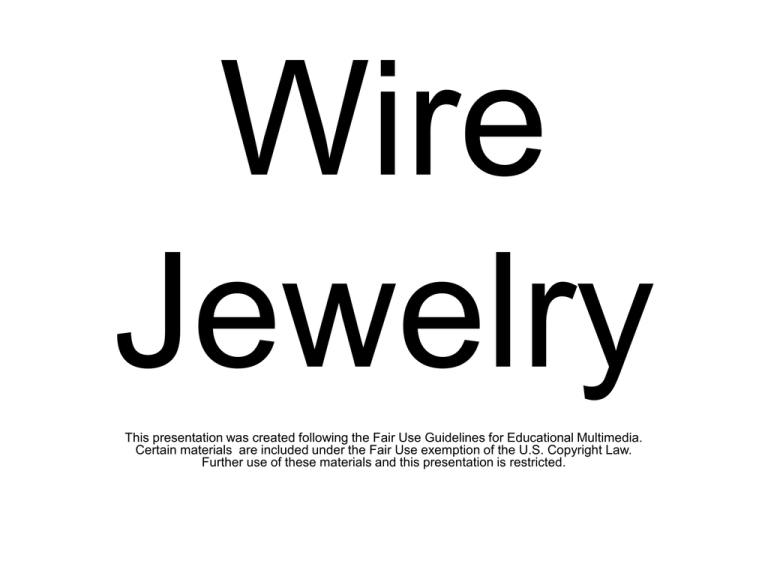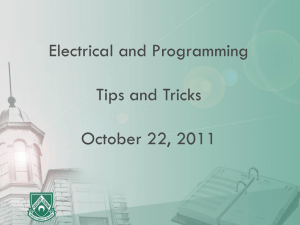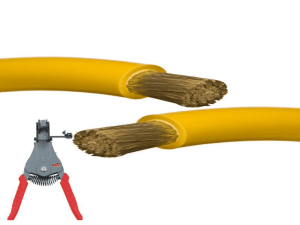Wire Jewelry
advertisement

Wire Jewelry This presentation was created following the Fair Use Guidelines for Educational Multimedia. Certain materials are included under the Fair Use exemption of the U.S. Copyright Law. Further use of these materials and this presentation is restricted. Tools • Bent chain nose - Chain nose pliers with a 45 degree bend for getting into tight places. Can also be used for picking up small parts, and opening and closing jump rings. • Chain nose - Pointed flat nose pliers, used for gripping and tucking in wire ends, and getting into tight places. • Round nose - Smooth, round jaws used for making loops and round bends in wire. • Flat nose pliers - Broad, flat jaws used for gripping and holding wire and creating angular bends. Also great for opening and closing jump rings. Tools • Flush cutter - A flush cutter is a jewelry wire cutter that is made to cut wire leaving one side of the cut to be flush (or flat) and the other side of the cut to be sharp (pointed). A conventional cutter will cut the wire leaving both sides semisharp. One side of the jaws on a flush cutter is flat, the opposite side is beveled. • End Cutter Nippers – Cutters used to cut wire and findings. They create a close, even cut. • Side Nippers – Use these to cut wire right next to an object. • Jig - A jig is a jewelry making tool with a series of pegs used to form or shape wire. Gauges Wire Hardness • Hardness - Hardness in wire is the property of how easy or how hard to bend the wire is. Soft wire is very easy to bend. Hard wire is stiff and springy • Full -Hard - Hard wire is the stiffest, least easy to bend and most springy of all the wire harnesses. This type of wire is not used a great deal because it is difficult to bend • Half Hard - In the middle of this range. This wire is stiffer than dead soft wire and not as stiff and springy as fully hardened wire. In general only gold, gold-filled, sterling silver and fine silver wire can be purchased with a hardness of 1/2 hard. • Dead Soft-This wire is very soft and can be bent with your hands. It is often used for wire-sculpted jewelry. Wire Attributes Disadvantages Advantages • Soft Wire • • 1/2 Hard Wire • • Hard Wire • Soft wire can be used to make spirals and other rounded shapes. Soft wire can be used for any application. Some it will do well some less well. 1/2 hard wire wraps tightly around itself or other wire. 1/2 hard wire makes sharp bends. 1/2 hard wire requires less hardening of the finished piece. Finished Pieces made in hard wire require no hardening. • • • • • • • Soft Wire isn't easy to use when wrapping wire around other wire. Soft Wire doesn't make sharp bends easily. Soft wire generally requires hardening of the finished piece. 1/2 hard wire can not be used for making spirals 1/2 hard wire requires that you push the wire beyond where you want it to end up, then remove your hands and test to see where the wire ends up once it has relaxed. Hard wire is very difficult to work with. Hard wire can not be used for making spirals or other rounded shapes. Findings • Finding - A finding is a jewelry making component, frequently made of metal. Ear wires, head pins, eye pins and clasps are examples of findings. • Ear Wire - A finding used to allow the wearing of earrings. The ear wire connects the earring body to the wearer's ear • Jump Ring - A jump ring is a metal finding that is round. Jump rings can be open like the one shown at right or they can be soldered closed • Yoke - A yoke is the center piece in a necklace. In the necklace at right you can view two yokes. This necklace is a project that allows you to interchange the yoke in a necklace. You can select the picture at right to view how to make this interchangeable yoke necklace. Techniques • A loop is essentially a circle made in a wire segment. • Open loop - Opening a loop is a jewelry making technique for using chain nose or bent chain nose pliers to open a loop without distorting the shape. By opening a loop you can connect other components to this loop, then close the loop while retaining the round shape of the loop. • A "P" loop is a loop made in wire where the loop is on one side of the wire. The shape of the loop and the wire makes this look like the letter "P", hence the name. • "U" shaped bend refers to bending wire in the shape of the letter "U". This bend is frequently made with the tips of your round nose pliers. This technique is frequently used when wrapping fine gauge wire around another wire component as shown at right. • A spiral is a wire component made by wrapping wire around itself in a flat plane. An example of a spiral is shown at right. Spirals can only be made in wire with a hardness of dead soft. • Quenching is a process for heat treating metals to change its hardness. This process involves heating the metal to a high temperature and then rapidly cooling it by dipping it in a liquid bath made of oil or water. • Hardening is the process of making a jewelry component more permanent and stiffer (hardening) by flexing the component repeatedly. This can be accomplished with your fingers or some level of work hardening is accomplished by the initial shaping of the wire with pliers and/or a jewelry making jig. Here are some do's and don'ts about choosing jewelry wire: • In general use 20G wire for earrings, 18G wire for Bracelet components and 18 or 16 G wire for necklace components. • In general use 20 or 22G wire for making wrapped bead links in bracelets and necklaces. • In general don't use 22G wire to make a wire component that must stand by itself, unless that component is very small. • In general, when buying 16G wire, buy soft wire, half-hard may be too stiff. • In general use soft wire for spirals and half-hard wire where you will have wrapped loops. • When making an ear wire, consider 20 or 21G wire. 22G wire is probably too thin and may be uncomfortable to wear. • Do not use Artistic Wire or any other dyed wire for making ear wires. The dyes have chemicals that do not belong inside the human body. Ideas http://www.xeniadesign.com/jewelry/bracelets/copperclover.jpg http://static.flickr.com/41/99847359_8075f32c2c.jpg http://www.victorianelegance.com/vf/vfj042.jpg http://www.xeniadesign.com/jewelry/necklaces/rusjade.jpg







